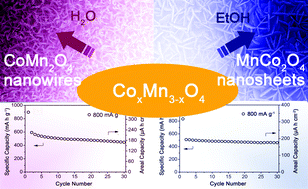While the idea of micro/ nanostructured electrode materials has been very effective for developing high-performance lithium-ion batteries, integrated 3D electrodes with hierarchical arrays are the boutique avenues going forward. A recent Energy and Environmental Science paper by Yu et al presents morphology-controlled tunable CoxMn3-xO4 structures that exhibit interesting electrochemical performance.
The strategy of growing electroactive nanostructures on conductive substrates to form integrated 3D electrodes is interesting not only from a device-design standpoint but also for efficient electron transport, as noted by the authors. The synthesis strategy used is robust and well controlled. I find their approach and implementation of direct growth of free-standing and tailored CoxMn3-xO4 structures on current-collecting substrates to be an important and logical step towards integrated electrodes for high performance energy storage devices.
Electrode materials for lithium-ion batteries are the poster child for structure-performance relationships. The interplay between electrochemical performance and morphology of the assembled structure is intriguing and for me makes a strong case for studying these materials in-operation. How does each of the components alter during charging-recharging, what is their role and could the entire framework look like a symphony?
Intrigued by this symphony? Read the paper!
Controlled synthesis of hierarchical CoxMn3−xO4 array micro-/nanostructures with tunable morphology and composition as integrated electrodes for lithium-ion batteries
Le Yu, Lei Zhang, Hao Bin Wu, Genqiang Zhang and Xiong Wen (David) Lou
DOI: 10.1039/C3EE41181H

By Prineha Narang











